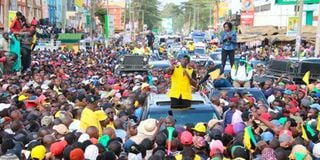Political rallies bad measure of electoral votes

Deputy President William Ruto addresses wananchi at Karatina town, Nyeri county during a Kenya Kwanza campaign rally on May 21, 2022.
Political rallies—from small roadside meetings to mass gatherings—have for a long time been central to the electoral campaigns in Kenya.
In the run-up to the August 9 general election, Kenyans had been attending and witnessing large crowds that thronged political campaign rallies in the respective party colours listening to an array of keynote speakers.
Apparently, the size of the crowd took the primacy of the election agenda. Notably, the rallies provided an avenue for the candidates to speak directly with voters, touting past accomplishments and promising goodies.
Political rallies are generally used for politicians to appeal to, or interact with, prospective voters in a bid to win elections. Above all, where clientelistic politics endured, candidates used the rallies to signal their readiness to act as patrons by giving handouts, including money and food, to the crowd.
All the presidential candidates—from Azimio, Kenya Kwanza, Roots Party and Agano Party—campaigned across the country optimistic to meet the constitution threshold.
The number of people seen in these rallies at times makes politicians get false confidence, impudence, hope and the belief that they have many voters or affiliated supporters. Some tend to think that these people attend their events because they like them—when, in fact, they do for other reasons. Notably, most of those who attend the rallies are either unemployed or just idle, hence making their mobilisation easier.
However, the elections were characterised by low turnout. Voter apathy was rife even before the election—particularly among the country’s youth, who form the majority of the electorate. According to IEBC, 60 per cent of the 22.1 million registered voters cast their ballots. On the contrary, turnout was nearly 80 per cent in 2017.
A political rally is a bad measure of the political muscle of a candidate, party or coalition. It’s just a show, with people coming out to make themselves euphoric, whether by seeing the politician, getting the handout or pickpocketing!
Mr Ngari is a communication and media student at Rongo University. [email protected].




